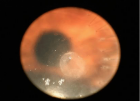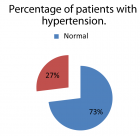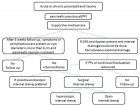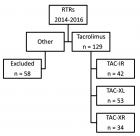Table of Contents
Juvenile Xanthogranulomatosis in a Hemophilic Boy: Case Report
Published on: 15th May, 2024
Juvenile Xanthogranulomatosis (JXG) is a condition, characterized by a proliferation of histiocytes, primarily observed in infants and young children. Cutaneous manifestations appear as yellow-orange-brown papules or nodules, typically localized on the face, neck, and upper chest. While most lesions regress spontaneously, some may require intervention for aesthetic, diagnostic, or hemorrhagic reasons. A rare case of disseminated JXG in a child with hemophilia has been reported. In this patient with severe hemophilia A, cutaneous nodules appeared, some associated with bleeding requiring appropriate management. Treatment included the administration of factor VIII to prevent bleeding during surgical procedures and secondary prophylaxis, to control recurrent bleeding. The outcome was favorable with the disappearance of the cutaneous lesions without sequelae, under regular surveillance for both medical conditions. This case highlights the rare association between juvenile xanthogranulomatosis (JXG) and hemophilia, a combination that has never been documented in the medical literature. This association only impacts the management of JXG when the cutaneous lesions bleed and their excision becomes necessary.
Obesity and Sex as Determinants of Atherogenic Risk Associated with High-Density (HDL) and Low-Density Lipoprotein (LDL) Subfractions in Adolescents: A Population-based Study Based on Health Survey of Sao Paulo
Published on: 6th May, 2024
Background: Worldwide, obesity in adolescents is an epidemiological concern. Overweight and obesity are associated with comorbidities in adult life, such as increased risk of hypertension and other non-communicable diseases. This study investigated possible differences between traditional lipid markers and Low-Density Lipoprotein (LDL) and High-Density Lipoprotein (HDL) subfractions in a population-wide representative sample of Brazilian adolescents. Methods: The individuals included in the study comprise a subsample of the 2015 Health Survey of São Paulo (ISA-Capital 2015). LDL and HDL particle sizes were determined by the Lipoprint® System (Quantimetrix Corporation). Results: 272 Brazilian adolescents with a mean age of 15.2 ± 2.2 years, of which 47.8% (n = 130) are boys. Analysis of LDL subfractions showed an increase in LDL 2 content in girls (5.7% vs. 5.1%; p = 0.047). This result was associated with a higher content of large LDL in girls (17.8% vs. 13.5%; p < 0.001) and a significant, lower content of small LDL (1.7% vs. 3.4%; p = 0.002). When obesity was considered, we observed that regardless of being overweight, girls had higher large and small LDL than boys. However, when a large to small LDL ratio was calculated, girls with no excess weight had higher values than boys with no excess weight (10.6 vs. 9.3; p = 0.038), and these had lower LDL ratio than overweight boys (9.3 vs. 13.5; p = 0.016). On the other hand, boys had higher HDL 2 content than girls (8.9% vs. 8.0%; p = 0.017), which was associated with increased large HDL values in boys (1.9% vs. 1.7%; p = 0.047). Regression analysis was performed according to gender, the sum of very low-density lipoprotein (VLDL) + intermediate density lipoprotein (IDL) C + IDL B subfractions was adjusted for age and body mass index (BMI), showing that girls had lower atherogenic lipid profile (β = 0.987; CI = 0.977-0.998; p = 0.017) than boys. When the regression analysis was performed according to BMI, large LDL in adolescents with no excess weight presented a lower atherogenic lipid profile (β = 1.040; CI = 1.000-1.082; p = 0.049), adjusted for age and sex, than overweight adolescents.Conclusion: Regardless of excess weight, girls showed a cardioprotective profile more associated with a favorable distribution of LDL subfractions than boys, reinforcing the relevance of evaluating qualitative aspects of lipoproteins in addition to the traditional cholesterol content.
Case Report: An Elusive Case of Septic Arthritis
Published on: 2nd May, 2024
Septic arthritis is a serious inflammatory infectious state of the joint secondary to microbial infection. In the pediatric population the most common route of infection is haematogenous spread. Less than fifty percent of patients with septic arthritis will yield positive culture results with a mortality rate of up to 42% in some cases. Due to the challenge in obtaining culture and identification of the causative organism the management of septic arthritis has been more of empirical in nature with the chosen antibiotic synchronized with the epidemiological data. Here is a case of a 14 months old female patient presenting at our hospital with a left knee and lower thigh swelling for three days with failure to bare weight on the limb. In addition, she had fever and diarrhea for three days. Upon evaluation clinical, laboratory and radiological findings supported septic arthritis expect for her blood, pus and synovial fluid culture of which all came back negative. She had poor response to intravenous ceftriaxone, gentamycin, metronidazole, ampicillin- cloxacillin and amoxicillin clavunate. Over the course of therapy, she developed septic shock, severe anemia and acute liver failure and was admitted to the intensive care unit. Afterwards she was initiated vancomycin and developed a hypersensitivity reaction with generalized edema which prompted cessation of the drug. Due to her critical state and poor response a triple therapy regimen composing of meropenem, ciprofloxacin and metronidazole was selected and maintained for three weeks followed by an oral clindamycin course for another three weeks of which she responded. In addition, surgical debridement arthrotomy, irrigation and drainage were done. Physiotherapy for rehabilitation is ongoing with patient recovering well.
Prevalence and Associated Factors of Hypoglycemia among Severe Acute Malnourished Children who admitted in East Gojjam Zone Public Hospitals from 2018 to 2021, Northwest Ethiopia, 2022. Multi-center Retrospective Cross Sectional Study
Published on: 29th April, 2024
Background: Globally, severe acute malnutrition (SAM) remains a major killer of children under 5 years of age. The highest magnitude is seen in sub-Saharan Africa, including Ethiopia. Hypoglycemia is the most common complication of severe acute malnutrition (SAM) and the most life-threatening condition in pediatric society. This study aimed to assess the prevalence of hypoglycemia and its associated factors among under-five children with severe acute malnutrition.Methods: A cross-sectional retrospective study was conducted among 378 randomly selected samples who were admitted to public hospitals in the East Gojjam zone from 2018 to 2021. Data was extracted from the medical records of the children and entered into SPSS version 26, Variables with a p – value < 0.25 in the Bivariate analysis were candidates for multivariable logistic regression and those with a p – value < 0.05 in the multivariable analysis were considered as having a statistically significant association with hypoglycemia among severe acute malnutrition.Results: Out of 378 respondents, 50 (13.2%) had hypoglycemia with severe acute malnutrition patients. Children admitted between the ages of 0-6 months were 2.93 (AOR = 1.57-6.25, p = 0.000), shocks were 4.6 (AOR = 1.25-17.42, p = 0.034), and fully immunized children were (AOR: 2.61 (1.01- 6.77, p = 0.048) was significantly associated with hypoglycemia with severe acute malnutrition. Conclusion and recommendation: The prevalence of hypoglycemia with severe acute malnutrition was 13.2%. We also recommend a longitudinal study should be done among children who develop hypoglycemia with severe acute malnutrition to determine the long-term consequences, especially the neurodevelopmental sequelae associated with this condition.
A Qualitative Study of Caregivers of Children Living with HIV/AIDS in Ghana: Diagnosis History, Health-seeking Behaviour, and Care Expectations
Published on: 5th April, 2024
Caregivers of Children Living with HIV/AIDS experience severe burdens in Africa amidst unmet needs while seeking care from hospitals. This study aimed to explore the diagnosis history, health-seeking behaviour, and care provided by hospitals and whether the services meet caregivers’ expectations. We used a qualitative approach and conducted individual in-depth interviews among purposively sampled caregivers of children living with HIV/AIDS from three hospitals. We achieved data sufficiency after interviewing nine participants. Audio-recorded interviews were transcribed verbatim and thematically analyzed manually through Collaizi’s steps. Four themes developed including; history of pregnancy and poor HIV testing, effective care for caregivers and CLWH, attitude of healthcare providers, and unmet expectations of care. Healthcare providers showed positive attitudes towards caregivers and provided services (counselling, dispensing Anti-retrovirals, health monitoring, and coordination of clinical care). Expectations bordered on financial support (for food, education, health care), and treatment for opportunistic infections. Findings indicate gaps in HIV voluntary testing for pregnant women, enrollment in Prevention of Mother to Child Transmission (PMTCT), and unmet needs. It is imperative to improve coverage of testing for pregnant women and efforts made to meet their needs. Financial support, provision of food security, and assistance for caregivers are essential for care.
Preparation of Healthy Cookies from Germinated Flour Blends of Finger Millet and Pearl Millet Sweetened with Jaggery
Published on: 2nd April, 2024
Millets are physiologically and therapeutically healthy with high nutritious value and are in rising demand in emerging markets like India, China, Africa, and other developing countries including the Western world. Germinated Millets have high digestibility and are used as healthy food for children’s growth and development. Climate change resilience technology, high nutritional value, and the announcement of the year 2023 as “International Millet Year” have made it very popular. Bakery items based on Millet, particularly cookies, are becoming more popular in both urban and rural areas. Jaggery is raw sugar prepared from sugarcane juice and is considered superior to white sugar. It offers numerous nutritional and therapeutic benefits, including anti-carcinogenic with antitoxic actions. Hence, this study aimed to prepare healthy food items with germinated finger and pearl Millets for better nutritional quality that are attracting the attention of health-conscious people on a worldwide scale. Cookies made from blends of germinated wheat flour (GWF), germinated finger millet flour (GFMF), and germinated pearl millet flour (GPMF) were examined for their physicochemical qualities, in vitro digestibility, antioxidant activity, and overall acceptability by consumers. In vitro protein digestibility (62.24-82.34%), starch digestibility (47.48-62.41%), total phenolic content (11.45–49.12 mg GAE/100 g), and antioxidant activities significantly increased as the proportion of GFMF and GPMF flour increased in the cookie samples, whereas total starch, dietary fiber, carbohydrate, and phytic acid decreased. The physical qualities of the cookies were also improved by the addition of GFMF and GPMF flours. Cookies with acceptable sensory properties, including taste, aroma, appearance, mouthfeel, crispiness, and overall acceptability, were produced by blending 60% GWF, 20% GFMF, and 20% GPMF (T2). This study demonstrated that GFMF and GPMF flour blends may be used as functional ingredients to create superior goods.
Pets and Pediatrics, Friend and Foe: Companionship Masking Illnesses
Published on: 8th March, 2024
Animals are companions that have continued to hold importance in the average American household. Traditional animals like dogs and cats are often treated as family members due to the human-animal bond. Although it seems as if there are many benefits to having animals in the home, it comes at a price—pet-borne illnesses. Compared to adults, the pediatric population is at a greater risk for these types of illnesses. Animals are natural reservoirs for many bacteria that may be passed to children, especially those who are immunocompromised. The goal of this article is to educate parents on the risks and symptoms of common pet-borne illnesses that are difficult to prevent from coming into the home.
An Individual Rehabilitation and/or Habilitation Program for Children with Disabilities (IPRH)
Published on: 23rd January, 2024
Introduction: The individual program of rehabilitation and (or) habilitation of children with disabilities (IPRH) is mandatory for execution by the relevant state authorities, local self-government bodies, as well as organizations regardless of organizational-legal forms and forms of ownership.Objective: To conduct a pilot analysis of the implementation of the IPRH contingent of patients of children with disabilities in an urban children’s clinic.Patients and methods: There were 366 reports on the implementation of measures provided for by an IPRH for a disabled person (disabled child) of 222 disabled. The organization of the study was in the nature of a continuous sample. The criterion for the inclusion of patients in it was the passage of an IPRH in a disabled child within a specified time frame. The following techniques were used: grouping, absolute and relative values, average values, detailing, and generalization. The threshold error probability for statistically significant differences was set at a level of 0.05.Results: The structure of the results of the control of the performance of IPRH in 222 disabled children according to the classes of diseases that caused the onset of disability (ICD) was as follows 1) G00-G99 - 35.47 ± 3.13%; 2) Q00-Q99 - 23.50 ± 2.77%; 3) 11.11 ± 2.05%; 4) C00-D48 - 10.25 ± 1.98%; 5) H60-H95 - 7.26 ± 1.67%; 6) M00-M99 - 2.99 ± 1.11%; 7-8) H00-H59 and P00-P96 - 2.14 ± 0.95%; 9-10) K00-K93 and S00-T98 - 1.29 ± 0.74% each; 11-12) I00-I99 and N00-N99 - 0.85 ± 0.60% each; 13-14) J00-J99 and L00-L99 - 0.43 ± 0.42% each.Conclusion: 1. In the structure of IPRH in 222 disabled children, according to the classes of diseases that caused disability (ICD), the following prevailed: 1) VI Diseases of the nervous system G00-G99 – 35.47%; 2) XVII Congenital anomalies, chromosomal disorders Q00-Q99 - 23.50%; 3) IV Diseases of the endocrine system, nutritional disorders, and metabolic disorders E00-E90 – 11.11%; 4) II Neoplasms C00-D48 - 10.25%; 5) VIII Diseases of the ear and mastoid process H60-H95 - 7.26%; 6) XIII Diseases of the musculoskeletal system and connective tissue M00-M99 - 2.99%; 7-8) VIII Diseases of the ear and mastoid process H60-H95 and VII Diseases of the eye and its adnexa H00-H59 - 2.14% each.2. The effectiveness of medical rehabilitation of disabled children was as follows: 1) Improvement - 23.26%; 2) Stabilization - 74.88%; 3) Deterioration - 1.86%. Dynamic observation was carried out on 94.26% of disabled children, drug therapy - 77.32%, non-drug therapy - 66.93%, and other types of medical rehabilitation were received by 14.48% of patients. Reconstructive operations were performed on 11.26% of disabled children.3. Prosthetics and orthotics were performed on 38.74% of disabled children. 32.43% of disabled children in need received sanatorium treatment, and 30.18% are currently in line to receive a voucher. For various reasons, 24.32% refused this type of rehabilitation; 3.60% of patients had contraindications at the time the voucher was provided.4. The obtained research results become the initial everyday statistical tool for objectifying the process of rehabilitation of patients and determining the strength and means of a medical institution to monitor and successfully implement an individual rehabilitation/habilitation program for a disabled person.
Delayed Diagnosis of Early-onset Sarcoidosis: A Case Report and Literature Review
Published on: 18th January, 2024
Background: Early-onset sarcoidosis is a rare systemic inflammatory granulomatous disease, distinguished by onset before the age of 4 and notably lacking pulmonary involvement. Unfortunately, the condition often shows clinical features similar to juvenile idiopathic arthritis, resulting in the misdiagnosis of numerous patients. This case report delves into the challenges associated with the delayed diagnosis of early-onset sarcoidosis, with a particular focus on the diagnostic methods employed to address this delayed recognition.Case presentation: A 15-year-old girl presented with a history of recurrent fever since infancy, accompanied by rash, arthritis, and joint deformity. Previously misdiagnosed with juvenile idiopathic arthritis, she underwent management with steroids and methotrexate, yielding no improvement. The diagnosis of early-onset sarcoidosis was made during adolescence based on serial examinations, comprehensive laboratory and radiological evaluations, and subsequent histopathology findings. Presently, the patient is receiving treatment with low-dose steroids and biologic therapy (Tocilizumab) and experiencing no disease progression.Conclusion: This case report underscores the importance of considering early-onset sarcoidosis in the differential diagnosis of pediatric patients exhibiting persistent arthritis from an early age. Early detection and treatment are crucial in averting complications and enhancing the overall quality of life.

HSPI: We're glad you're here. Please click "create a new Query" if you are a new visitor to our website and need further information from us.
If you are already a member of our network and need to keep track of any developments regarding a question you have already submitted, click "take me to my Query."



















































































































































